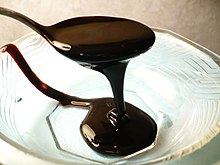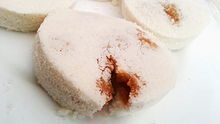Molasses

Molasses,[1] or black treacle (British, for human consumption; known as molasses otherwise), is a viscous by-product of the refining of sugarcane or sugar beets into sugar. The word comes from the Proto-Indo-European mélid. Cognates include Ancient Greek μέλι (méli) (honey), Latin mel, Spanish melaza (molasses), French miel (honey), and Portuguese melaço.[2] Molasses varies by amount of sugar, method of extraction, and age of plant.
Sweet sorghum syrup may be colloquially called "sorghum molasses" in the southern United States.[3][4][5][6]
Cane molasses

Cane molasses is a common ingredient in baking and cooking.[7][where?]
To make molasses, sugar cane is harvested and stripped of leaves. Its juice is extracted usually by cutting, crushing, or mashing. The juice is boiled to concentrate it, promoting sugar crystallization. The result of this first boiling is called "first syrup", and it has the highest sugar content. First syrup is usually referred to in the Southern states of the U.S. as "cane syrup", as opposed to molasses. "Second molasses" is created from a second boiling and sugar extraction, and has a slight bitter taste.
Blackstrap molasses
The third boiling of the sugar syrup yields dark, viscous blackstrap molasses, known for its robust flavor.[8] The majority of sucrose from the original juice has been crystallised and removed. The calorific content of blackstrap molasses is mostly due to the small remaining sugar content.[9][10] Unlike highly refined sugars, it contains significant amounts of vitamin B6 and minerals, including calcium, magnesium, iron, and manganese; one tablespoon provides up to 20% of the recommended daily value of each of those nutrients. Blackstrap is also a good source of potassium.[11] Blackstrap molasses has long been sold as a dietary supplement.
Blackstrap molasses is significantly more bitter than "regular" molasses. It is sometimes used in baking. This residual product of sugar refining is used for producing ethanol and as an ingredient in cattle feed and as fertilizer.
The term "black-strap" or "blackstrap" is an Americanism dating from 1875 or before.[12] Its first known use is in a book by detective Allan Pinkerton in 1877.[13]
Sugar beet molasses
Molasses made from sugar beets differs from sugarcane molasses. Only the syrup left from the final crystallization stage is called molasses; intermediate syrups are called high green and low green, and these are recycled within the crystallization plant to maximize extraction. Beet molasses is 50% sugar by dry weight, predominantly sucrose, but contains significant amounts of glucose and fructose. Beet molasses are limited in biotin (vitamin H or B7) for cell growth; hence, it may be supplemented with a biotin source. The non-sugar content includes many salts, such as calcium, potassium, oxalate, and chloride. It contains betaine and the trisaccharide raffinose. These are as a result of concentration from the original plant material or chemicals in processing, and make it unpalatable to humans. Hence it is mainly used as an additive to animal feed (called "molassed sugar beet feed") or as a fermentation feedstock.[citation needed]
It is possible to extract additional sugar from beet molasses through molasses desugarization. This exploits industrial-scale chromatography to separate sucrose from non-sugar components. The technique is economically viable in trade-protected areas, where the price of sugar is supported above market price. As such, it is practiced in the U.S.[14] and parts of Europe. Molasses is also used for yeast production.
Unsulphured molasses
Many kinds of molasses on the market come branded as unsulphured (using the original British spelling of sulfur). Many foods, including molasses, were treated with sulfur dioxide as a preservative, helping to kill off molds and bacteria. Sulfur dioxide is also used as a bleaching agent, and helped to lighten the color of molasses. Most brands have veered away from sulphured molasses, due to the relatively stable natural shelf life of untreated molasses, the off flavor that can arise from using sulfur dioxide, and the fact that sulfur dioxide in high doses can be toxic.[15]
Other forms

In Middle Eastern cuisine, molasses is produced from carob, grapes, dates, pomegranates, and mulberries. In Nepal it is called chaku[16] (Nepal Bhasa: चाकु) and used in the preparation of Newari condiments such as yomari.
Other uses
Food products and additives

Molasses can be used:
- In dark rye breads or other whole grain breads
- In some cookies and pies
- In barbecue sauces
- In beer styles such as stouts and porters
- The principal ingredient in the distillation of rum
- As a humectant in jerky processing
- An iron supplement
- An additive in livestock feeds
- An ingredient in fishing groundbait
- A source for yeast production
- The main ingredient in the production of citric acid
- An additive in tobacco smoked in a hookah, shisha, or narghile (found in the brands The King, Al Fakher Tobacco, Cedars Tobacco, Mazaya, Nakhla, Tangiers, Salloum, and Hookafina Blak)[citation needed]
Chemical
- The carbon source for in situ remediation of chlorinated hydrocarbons
- Blended with magnesium chloride and used for de-icing
- A stock for ethanol fermentation to produce an alternative fuel for motor vehicles
Industrial
- As a minor component of mortar for brickwork[17]
- Mixed with glue to case ink rollers on early printing presses
Horticultural
- As a soil additive to promote microbial activity[18]
- As a potato plant "cicatrizant" after a hail storm
Nutritional information
| Nutritional value per 100 g (3.5 oz) | |
|---|---|
| Energy | 1,213 kJ (290 kcal) |
74.73 g | |
| Sugars | 74.72 g |
| Dietary fiber | 0 g |
0.1 g | |
0 g | |
| Vitamins | Quantity %DV† |
| Thiamine (B1) | 3% 0.041 mg |
| Riboflavin (B2) | 0% 0.002 mg |
| Niacin (B3) | 6% 0.93 mg |
| Pantothenic acid (B5) | 16% 0.804 mg |
| Vitamin B6 | 39% 0.67 mg |
| Choline | 2% 13.3 mg |
| Minerals | Quantity %DV† |
| Calcium | 16% 205 mg |
| Iron | 26% 4.72 mg |
| Magnesium | 58% 242 mg |
| Manganese | 67% 1.53 mg |
| Phosphorus | 2% 31 mg |
| Potassium | 49% 1464 mg |
| Sodium | 2% 37 mg |
| Zinc | 3% 0.29 mg |
| †Percentages estimated using US recommendations for adults,[19] except for potassium, which is estimated based on expert recommendation from the National Academies.[20] | |
Molasses contains no protein or dietary fibre and close to no fat. Each tablespoon (20 g) contains 58 kcal (240 kJ), 14.95 g of carbohydrates, including 14.94 g of sugar[21] divided between sucrose, glucose and fructose in rough proportions of 2:1:1.
Important minerals
Minerals in Meridian/Organic/Pure blackstrap - per 100 g (equivalent to 5 tablespoons):
- Calcium: 400 mg (50% RDA)
- Iron: 13 mg (95% RDA)
- Magnesium: 300 mg (38% RDA)
See also
- Anadama bread
- Brown sugar
- Caramelization
- Great Molasses Flood
- Maillard reaction
- Pekmez
- Shoofly pie
- Syrup
- Treacle
References
- ^ "molasses Definition in the Cambridge English Dictionary". cambridge.org.
- ^ "Molasses" at Dictionary.com
- ^ Rapuano, Rina (September 12, 2012). "Sorghum Travels From The South To The Mainstream". npr.org. Retrieved May 22, 2014.
- ^ Bitzer, Morris (2002). "Sweet Sorghum for Syrup" (PDF). N.p.: University of Kentucky. Retrieved 22 May 2014.
- ^ Curtin, Leo V. "Molasses - General Considerations" (PDF). Institute of Food and Agricultural Sciences and University of Florida, n.d. Retrieved May 22, 2014.
- ^ "Ventilated" (PDF). Indiana State Department of Health - Division of Consumer Protection - Food Protection Program Guidance on Sorghum Production, March 19, 2008 (2008): 1-6. March 19, 2008. Retrieved May 22, 2014.
- ^ "Cooking with Molasses - Brer Rabbit Molasses Recipes - Easy Baking Recipes". Brer Rabbit.
- ^ "Health Benefits of Blackstrap Molasses". Spiritfoods. Retrieved 6 September 2012.
- ^ "Blackstrap Molasses In-depth nutrient analysis". The World's Healthiest Foods. Retrieved 6 September 2012.
- ^ "Molasses, Blackstrap". Barry Farm Foods. Retrieved 23 June 2012.
- ^ "Molasses, blackstrap". NutritionData. Retrieved 27 August 2012.
- ^ "Local and Personal". The Cambria Freeman (1867-1938). Ebensburg, Pa. March 26, 1875. p. 3. Retrieved 2015-10-24.
- ^ Pinkerton, Allan (1877). The Molly Maguires and the Detectives, 1905 ed. New York: G. W. Dillingham Co. Retrieved 2009-07-08.
- ^ "Chromatographic Separator Optimization" at Amalgamated Research Inc.
- ^ T, Eric (October 8, 2012). "Why Does my Mollases say Unsulphured? Was Sulphur Removed From it?". CulinaryLore.com. Retrieved August 20, 2015.
- ^ "Locals prepare molasses for festival in Nepal". Retrieved 29 September 2014.
- ^ Heath, Arthur Henry (1893). A Manual on Lime and Cement, Their Treatment and Use in Construction. Mackaye Press. Retrieved 2015-10-24.
- ^ "Bioactive materials for sustainable soil management" (PDF). bfa.com.au.
- ^ United States Food and Drug Administration (2024). "Daily Value on the Nutrition and Supplement Facts Labels". Retrieved 2024-03-28.
- ^ National Academies of Sciences, Engineering, and Medicine; Health and Medicine Division; Food and Nutrition Board; Committee to Review the Dietary Reference Intakes for Sodium and Potassium (2019). Oria, Maria; Harrison, Meghan; Stallings, Virginia A. (eds.). Dietary Reference Intakes for Sodium and Potassium. The National Academies Collection: Reports funded by National Institutes of Health. Washington (DC): National Academies Press (US). ISBN 978-0-309-48834-1. PMID 30844154.
{{cite book}}: CS1 maint: multiple names: authors list (link) - ^ "Basic Report: 19304, Molasses". USDA Agricultural Research Service. Retrieved 25 January 2016.
External links
![]() Media related to Molasses at Wikimedia Commons
Media related to Molasses at Wikimedia Commons
